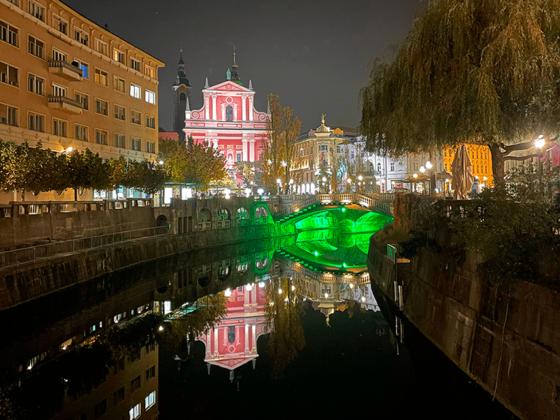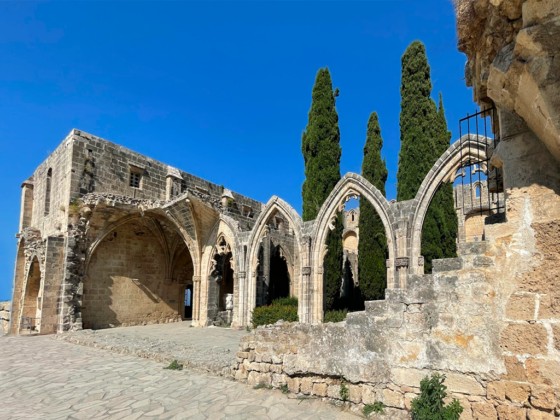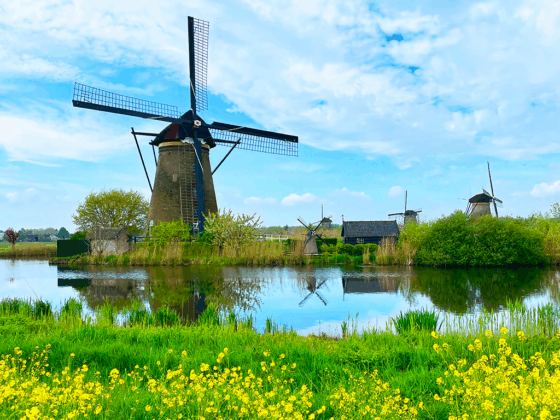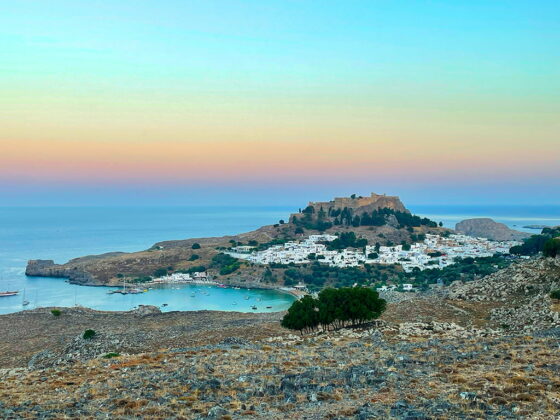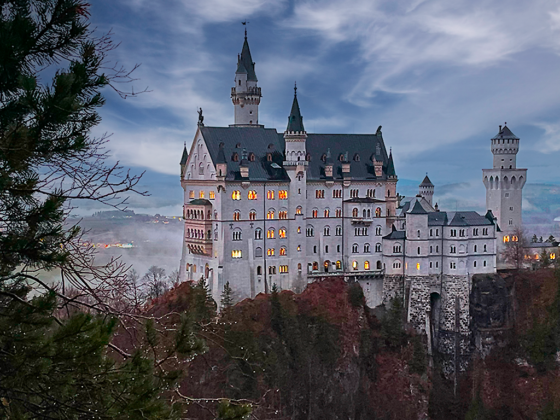When choosing a new travel destination, I often let myself be guided by the curiosity that a place arouses in me. I like to read, inform myself and learn everything about places and traditions… and the more I want to discover, the more I want to go.
Cyprus, the third largest island in the Mediterranean, is a rich destination – from archaeology to religion, architecture to gastronomy, hiking trails and crystal clear sea – it is an island waiting to be discovered, suitable for travellers like us who like to move far and wide.
Cyprus is also a land of controversial nature where the history of two peoples is intertwined. The island is divided in two: in the south the Democratic Republic of Cyprus, in the north the Turkish Republic of Northern Cyprus. In the south Greek is spoken and people pay in euros, in the north the language is Turkish and the currency is the Turkish lira. Dividing them is the green line, drawn by the UN after the occupation that began with the war in ’74 and ended with the self-proclamation of a republic recognised only by Turkey. The capital – Nicosia for the Greeks, Lefkosia for the Turks – is the last city in Europe to be divided by a wall: there is a real customs post with policemen and passport control, and between the war-torn buildings a line made of petrol drums, sandbags and control towers.
The border for tourists is absolutely quiet, both the Greek and Turkish sides are kind and hospitable to visitors, you just have to get used to the presence of the military – and their bases scattered all over the island – different languages and currencies, and the dreaded left-hand drive.
All this is food for my curiosity!
- Itinerary in a nutshell
- Day 1: Larnaca
- Day 2: Hala Sultan Tekke, Panagia Angeloktisi, Stavrovouni Monaster, Lefkara , Choirokoitia, Governor’s Beach, Limassol
- Day 3: Ancient Kourion, Temple of Apollo, Avdimou Beach, Kolossi Castle and Kourion beach.
- Day 4: Caledonia and Pouziaris Natural Trail (Caledonia Waterfall), Omodos, Kykkos Monastery, Pafos
- Day 5: Blue Lagoon and Aphrodite’s Baths
- Day 6: Avakas Gorge Nature trail, Lara beach, Adonis Bath Waterfalls
- Day 7: Nea Pafos, Tomb of the Kings, Petrou de Romiou (Aphrodite’s beach), Nicosia
- Day 8: Nicosia
- Day 9: St. Hilarion Castle, Kyrenia, Bellapais Abbey, Dipkarpaz
- Day 10: Karpaz Peninsula, Golden beach, Sea Bird beach, Cape of the Apostle Andrew, Agia Filon
- Day 11: Salamina ruins, Famagasta and Aya Napa
- Day 12: Gliki Nero Beach, Bridge of lovers, Ammos Kambouri Beach, Limnara Beach
- Day 13: Nissi and Macronissi beach
- Day 14: Konnos beach, Cyclops cave, Blue Lagoon, Greek Cape, Sea caves
- Day 15: Departure
Itinerary in a nutshell
Our trip lasted 15 days exploring both the Democratic Republic of Cyprus and the Turkish Republic of Northern Cyprus, crossing the border four times, two on foot and two by car.
Driving 1250 km we went from the top of the Akamas peninsula, to the easternmost rock of the Karpaz peninsula to the southernmost tip of Cape Greco.
We slept in Larnaca, Limassol, Pafos, Nicosia, on Golden Beach and in Agia Napa stopped in Girne and Famagusta and walked through the villages of Lefkara, Kiti and Omodos.
We rested on the island’s most beautiful beaches – Blue Lagoon, Golden Beach, Governor’s Beach, Lara Beach, Nissi Beach, Sea Bird Beach and Konnos Beach – and immersed ourselves in the wilderness by walking the Kaledonia Waterfalls trail, part of the Pouziaris trail, the Avakas Gorge Nature Trail and the trails between the Sea caves and Konnos Bay.
We did not miss visits to the major archaeological sites – the Archaeological Site of Nea Paphos, the Tomb of the Kings and the Salamis Ruins – and stops such as the magical Kikkos Monastery, the fairy-tale Castle of St Ilarion, the unmissable Bellapais Abbey and the impressive Kourion Ancient Amphitheatre.
If you are curious to find out more, here are the stages of our journey day by day.
Day 1: Larnaca
Our plane lands at Larnaca airport at 16:35. Having collected our bags, we head to the car park to collect our car. As soon as we leave the airport the warm air and the smell of sunburnt earth and plants envelops us and I feel a bit at home. Taking possession of our white KIA Stonic – with the steering wheel decidedly on the wrong side – we drive about 8 kilometres to our first destination, Larnaca.
Tips for Trips: before you become familiar with left-hand drive it may take some time and sweat, hiring a car with automatic transmission is highly recommended!
After a very short stop at the hotel to reorganise our backpacks, we set off to explore the city.
Larnaca is a peculiar city, modern but at times decadent.
In the old town is the beautiful Agios Lazaros, a church built on the site where the remains of St Lazarus were found, today preserved in a tomb inside. According to legend, Lazarus, after being resurrected in Palestine, was exiled by the Pharisees who abandoned him on a boat that reached the shores of Larnaca. Here he spent the rest of his life, was appointed bishop of the city and died there, for his second and last time.
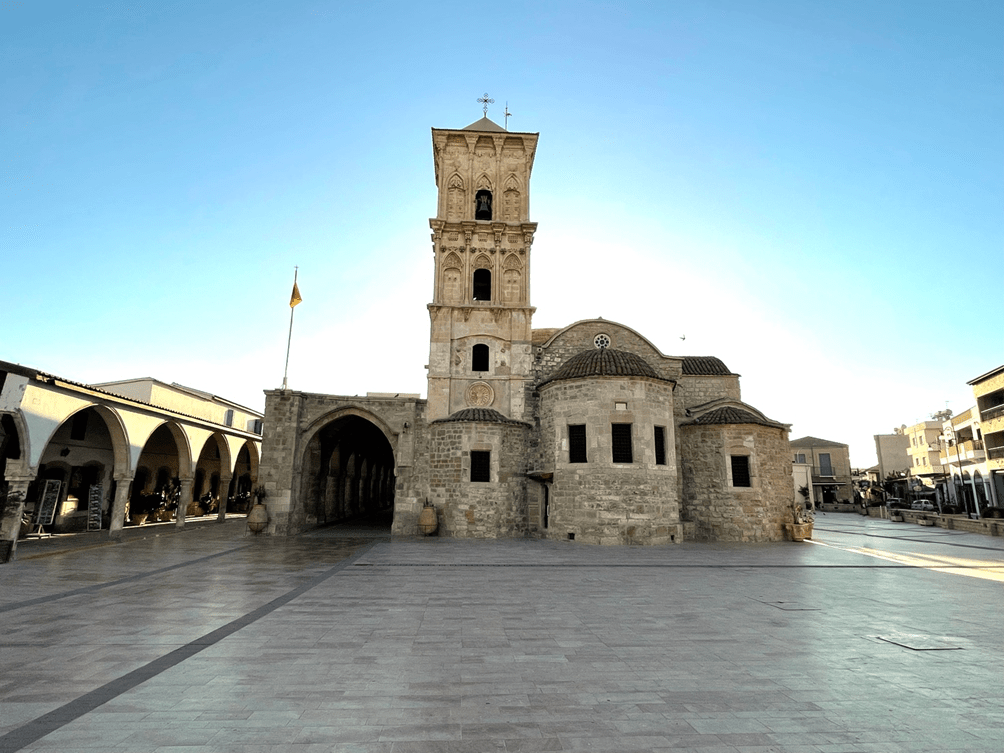
Heading towards the sea, we visit the Cami Kebir Mosque, the spiritual centre of the Muslim community, used for worship but which can be visited – it is compulsory to dress appropriately – and, overlooking the sea, the Larnaca Fortress, built by the Ottomans in 1625, which divides the Finikoudes – the city promenade – from the old Turkish quarter.
In both directions, the promenade is full of numerous restaurants and taverns where you can eat good fresh fish overlooking the sea. We thus end our visit to the city, eating good fish and sipping Zivania, a typical Cypriot drink.
Day 2: Hala Sultan Tekke, Panagia Angeloktisi, Stavrovouni Monaster, Lefkara , Choirokoitia, Governor’s Beach, Limassol
We leave Larnaca in the direction of Limassol, where we will sleep for the next two nights. Our itinerary begins with a visit to the Hala Sultan Tekke, on the western shore of the Larnaka Salt Lake – a shallow expanse of brackish water that in summer, totally drained by the heat, becomes a shimmering expanse of salt.
Tips for Trips: the Hala Sultan Tekke is about 1km from the main road connecting the airport to Larnaka, so if you have some time on your arrival, you can make a diversion.
The Hala Sultan Tekke is a complex consisting of a mosque and adjoining tekke (monastery) surrounded by olive trees, cypresses and palm trees. The mosque is still in use and is a very important place in the Islamic world as it has a deep religious significance. Legend has it that it was built on the site where Muhammad’s revered paternal aunt died after falling from a horse while fleeing from Byzantine soldiers. To visit it, one must wear sober clothes and be properly covered. To visit the prayer hall, which is very simple and modest, one must remove one’s shoes and observe a religious silence.
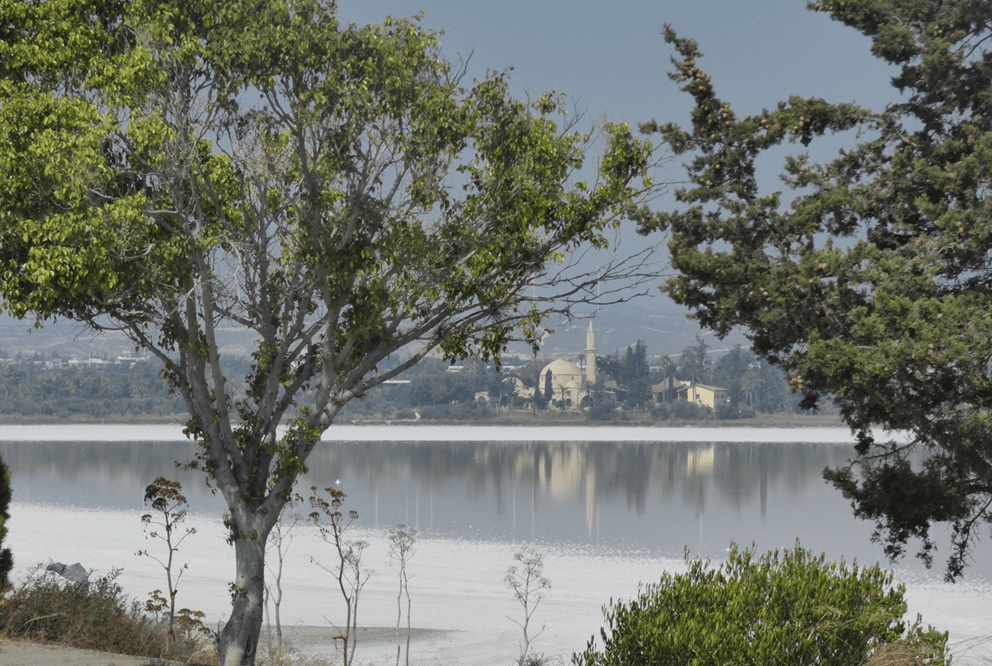
Moving southwest of Larnaca we pass through Kiti to visit the splendid Panagia Angeloktisti, literally ‘built by angels’. According to legend, in the 5th century the inhabitants of Kition – present-day Larnaka – tired of pirate raids decided to move the settlement inland and founded Kiti. During the construction of the church, they saw angels move its foundations to its current location and erect it. The church dates back to the 10th century and is built in Byzantine style with domed vaults. It houses the Mosaic of the Virgin Mary, found in the ruins of the original apse, incorporated into the present building.
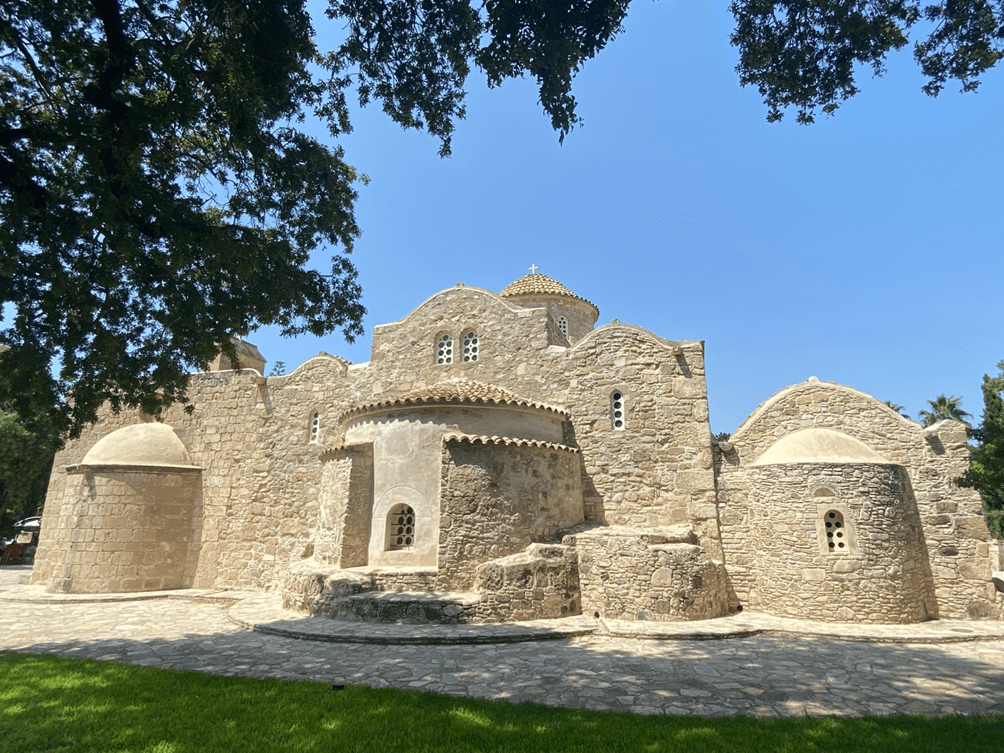
Next stop is the Stavrovouni Monastery, located on the mountain of the same name, where the oldest monastic community in Cyprus lives. Women are not allowed to enter as a strict monastic rule is in force but, thanks to its location, it offers a beautiful view of much of the island (but that alone is not worth the drive).
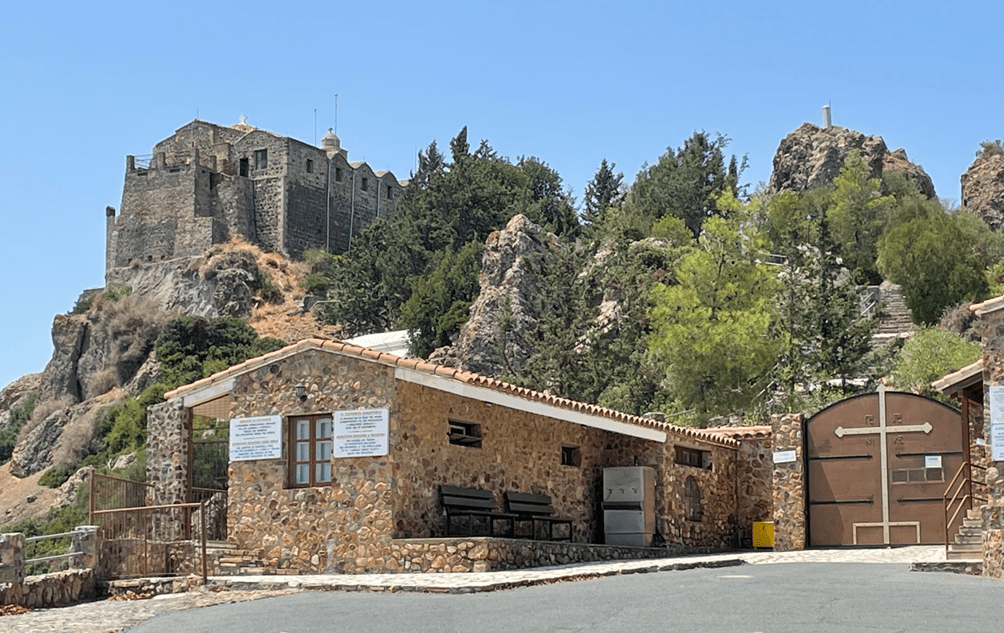
For lunch, we head towards Lefkara, taking the road up the slopes of the Troodos Mountains. The village is divided into two small centres: Pano Lefkara higher up and Kato Lefkara at a slightly lower altitude. We decide on the former. The village is known for its lace and silver craftsmanship and it is still common to see women sitting outside their houses working together. We take a walk along the narrow streets of the village, which is home to many small shops and some nice, cosy taverns.
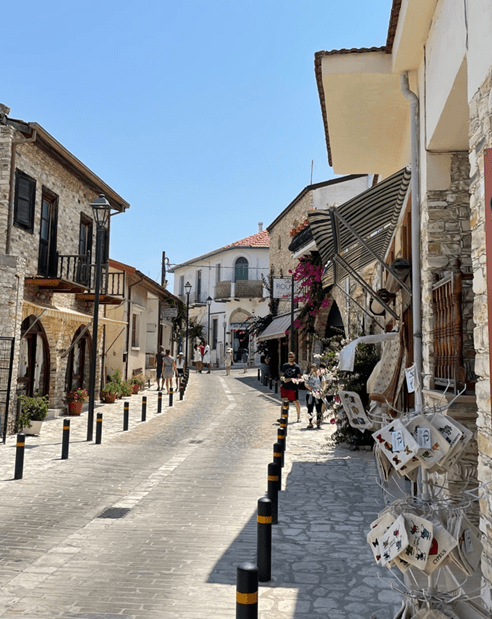
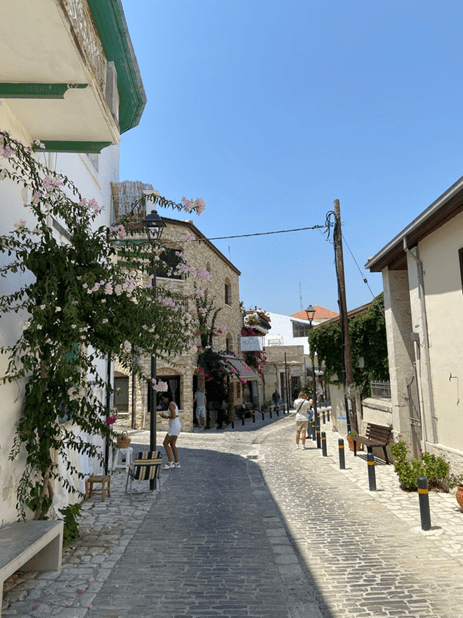
After a hearty lunch, we get back on the road and reach the site of Choirokoitia. This is one of the most important prehistoric sites in the entire Eastern Mediterranean, under UNESCO protection since 1998. The village, dating back to the 9th millennium B.C., is located on the slopes of a hill protected by a wall system and extends over 3 hectares. It consists of circular houses built of brick and stone with flat roofs. Under these dwellings, funerary remains have been found that are useful for obtaining information on the religious practices of the times and an estimate of the average age. In addition, the numerous tools found have proven the high degree of specialisation in agriculture and hunting.
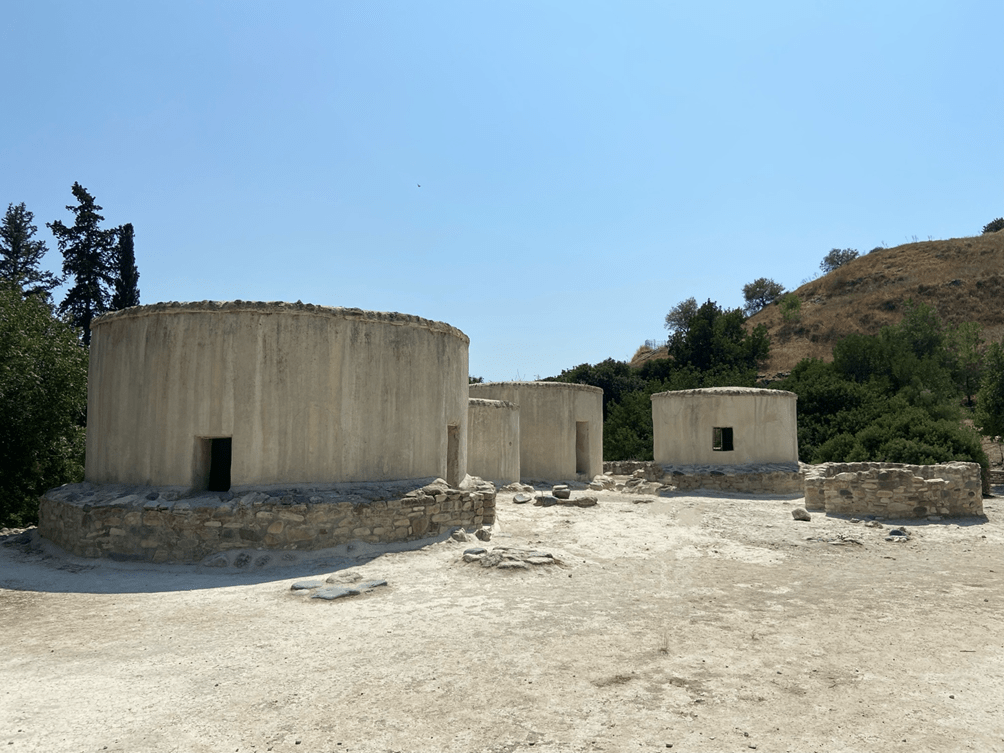
The last, refreshing stop is Governor’s beach, on the coast between Larnaca and Limassol. It is a 2 km coastline with numerous coves with black sandy beaches, white chalk rocks and deep, crystal-clear waters. Despite the dissenting opinion of many – due to the presence of a power plant in the distance – we really enjoyed the contrast between the colours and its deep, clean waters. On the hill behind, there are bars and taverns where you can have a cool drink while enjoying the breathtaking view.
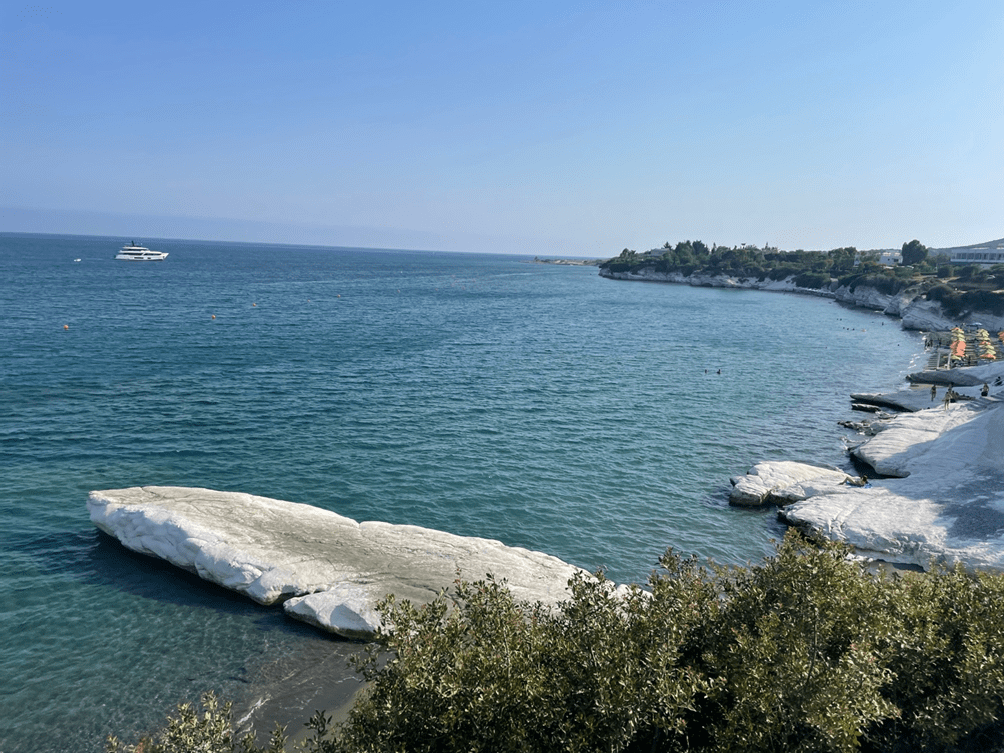
Arriving at our new base, after a very short stop to recuperate, we set off to discover Limassol in search of a good place to eat (I ALWAYS think of a good place to eat). We are immediately struck by its vibrancy and beauty. Its historical centre is nestled around the Medieval Castle, famous because the wedding between Richard the Lionheart and Berengaria of Navarre took place there. From there, a multitude of quaint little streets wind their way, where the past blends perfectly with the modern, between old houses and recent cafés and restaurants. Walking in the direction of the sea, one reaches the Marina, also new and modern, full of cafés and bars.
Day 3: Ancient Kourion, Temple of Apollo, Avdimou Beach, Kolossi Castle and Kourion beach.
The day is dedicated to the historical part of Limassol. We start by heading to Ancient Kourion, a settlement dating back to the 13th century BC. The site is located near Limassol but we prefer to arrive early to beat the arrival of the tourist buses and avoid the hottest hours. The site is very large and it takes at least three hours to visit it all but the route is very well signposted and easy to follow. It is also located high above Episkopi Bay and offers wonderful views of the sea and coastline. Not to be missed! Among the most beautiful monuments is the imposing amphitheatre, which has been perfectly restored and still hosts plays, concerts and ballets. Nearby is the Villa of Eustolios, a private residence built by a wealthy 5th century Christian inhabitant decorated with exquisite mosaics, and an interesting Roman bath complex with an ingenious underfloor heating system. Other mosaics are preserved at the House of Achilles and the nearby House of the Gladiators.
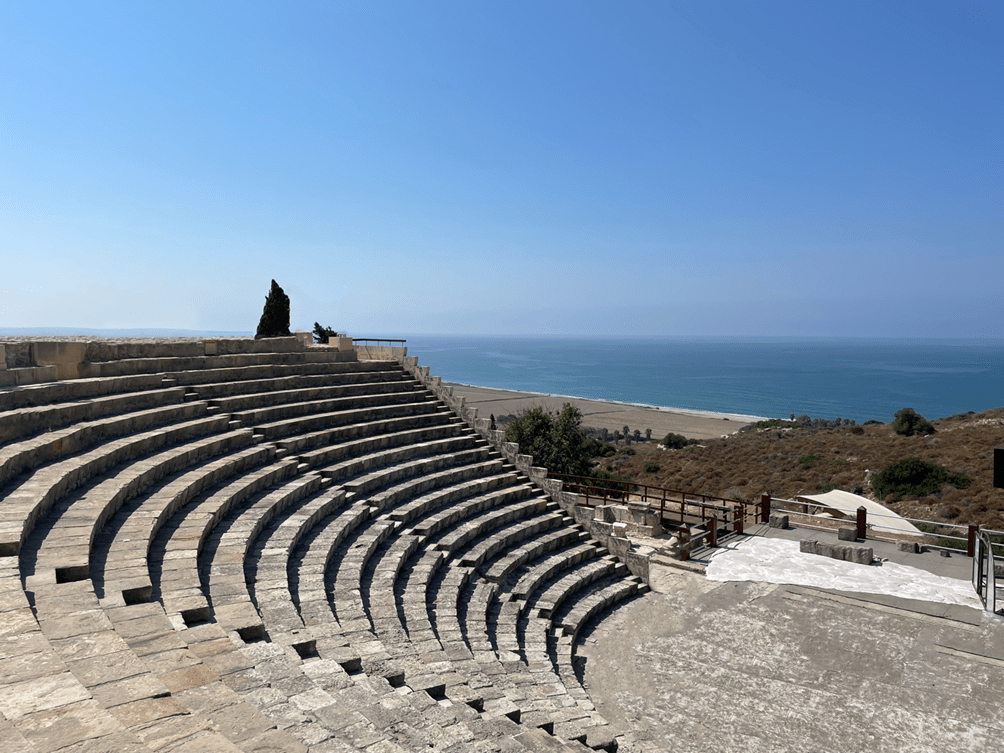
Adding a stop, the Sanctuary of Apollo Hylates (God of the Woods), was not on the agenda but marked on the site map made us curious. Approximately 2.5km from the main site of Kourion, it can be visited in less than an hour and is interesting for the ruins of the temple dedicated to Apollo, as well as having been in the past one of the gateways for outsiders heading for Kourion.
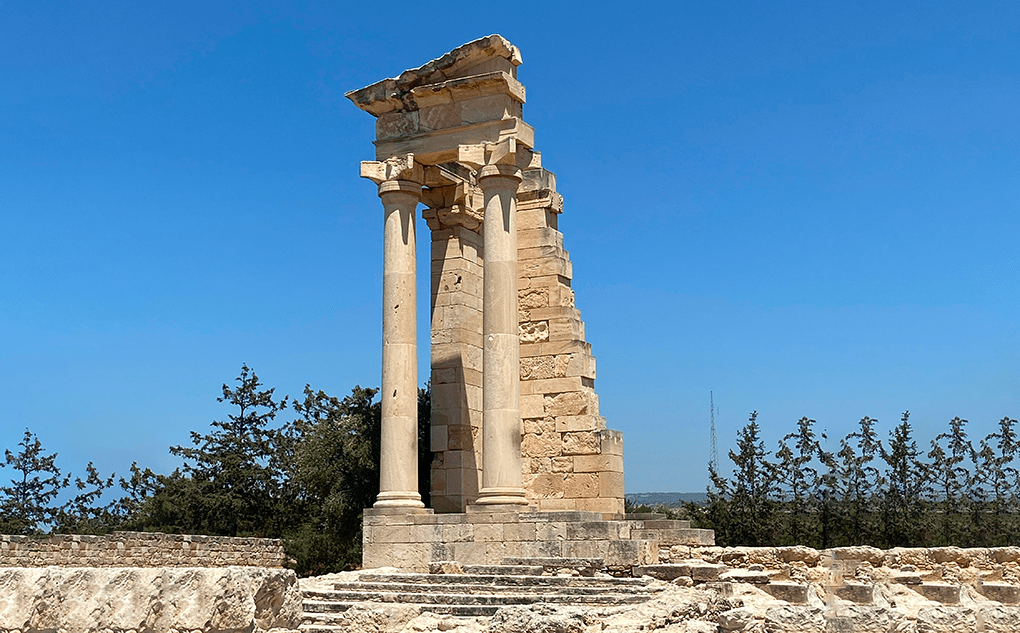
For lunch, we move on to Avdimou Beach because it seems that the catch of the day is really good here, so we throw ourselves into tasting it.
It is the turn of Kolossi Castle, a former Crusader stronghold southwest of the village of Kolossi, about 14 kilometres from Limassol. The original castle was built in 1210 by the Frankish army while the current one dates back to the mid-15th century, a period when the Crusaders ruled the area, producing wine and processing sugar cane. The structure consists of two large overlapping halls on the 1st and 2nd floors, while a steep spiral staircase leads to the roof, from where there is a view over the entire area.
We were scheduled to visit Lady’s Mile Beach, but due to the strong wind we switched to Kourion Beach, which, probably because of the weather, did not particularly impress us.
Day 4: Caledonia and Pouziaris Natural Trail (Caledonia Waterfall), Omodos, Kykkos Monastery, Pafos
The day starts early in the morning, we have a few kilometres to go before we get to one of the most anticipated hikes of the holiday: we want to arrive early so as not to find the trail crowded. The plan is to walk the Caledonia Waterfall Trail uphill and follow part of the Pouziaris Nature Trail downhill, an 8km loop. The Caledonia Waterfall Trail is 3 km long, with about 400 m of altitude difference and is also passable in summer as it is shaded. It starts 1 km downstream from Troodos Centro and ends just outside Platres. The path winds through dense woods in a valley following the Kyros stream, with crossings over stones and small wooden bridges, and is quite steep in places. The woods it passes through have a very varied vegetation with black pines and Mentha cyproca and are populated by many small birds. Halfway along the trail is the Caledonia Waterfall, which drops from a 15 m high precipice. The Pouziaris Nature Trail – at least the part that is covered – is a path that descends between the mountains, exposed and not very sheltered from the sun – the vegetation is sparse and sunburnt – but it offers spectacular views of the entire valley.
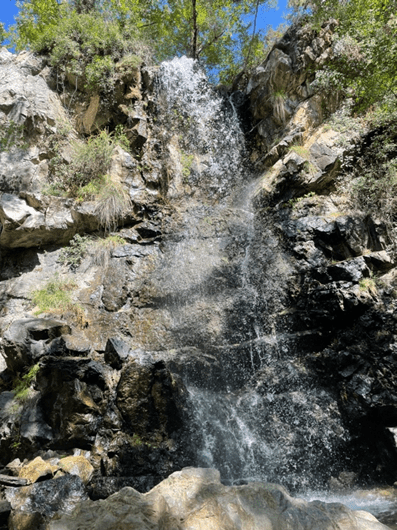

Tips for Trips: for most of the route the internet doesn’t take, I recommend downloading a GPS map. For my routes I often use Wikiloc.
For lunch, we stop in Omodos, a traditional village in the Troodos Mountains, considered the wine capital of Cyprus. The village has developed around the monastery complex of Timios Stravros and its square overlooked by taverns and souvenir shops. The old centre has been perfectly restored and the old stone houses now house small shops with handicrafts. It is a pleasant place to spend a few hours strolling around or having lunch in some of the local taverns.

Passing through the Trodos Mountains, one cannot fail to stop at the Kykkos Monastery. It is located at an altitude of 1318 and the road to get there is long and winding but absolutely worth it. The buildings of the monastic complex date from different eras. In the centre is the temple, around it various sections of the abbey. On the upper floor is the library and the monks’ cells. Next to the temple is a large paved courtyard with a well. Further on, stairs lead to the lower floor with another open courtyard with a large well in the centre and a shop with monastery products, we bought an exquisite amber Zivania. Right in front of the shop is a huge mosaic of the Virgin Mary. Next to it is the monastery church. The interior leaves one speechless with its decorations and the light it emanates. It is L-shaped and consists of two different churches: the first in the form of an elongated basilica, the second in the form of a centred Greek cross.
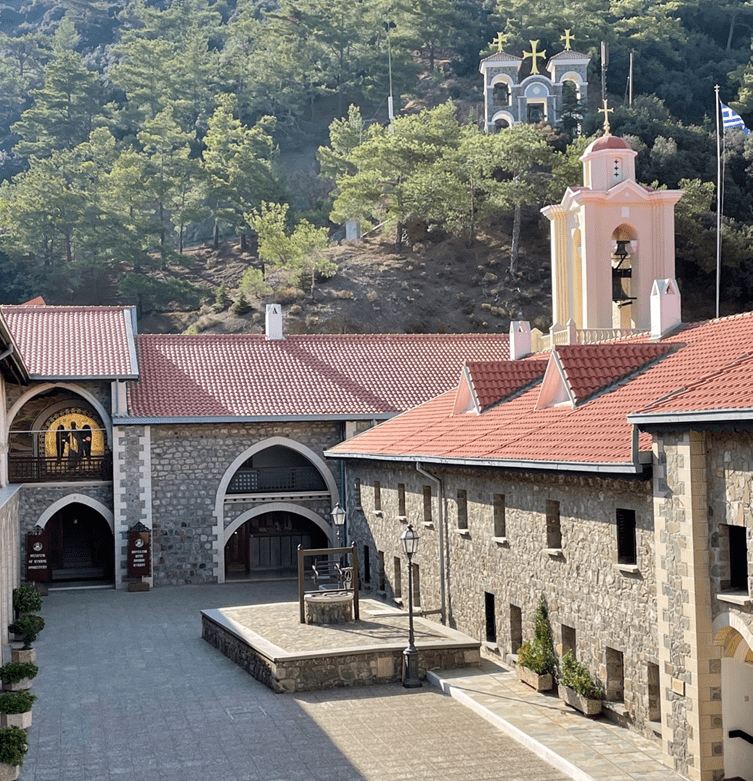
We end the day in Pafos, which will host us for the next three nights. Kato Pafos (Lower Pafos) is the tourist centre with a lively waterfront, crowded with bars, tavernas and shops and adorned with palm trees. Ktima (Upper Pafos) is the old town, teeming with small cafes interspersed with colonial buildings and illuminated fountains.
Day 5: Blue Lagoon and Aphrodite’s Baths
A day dedicated to the northern part of the Akamas peninsula with its wonderful Blue Lagoon, another must-see. The peninsula is a large spur of coastal rocks interspersed with sandy inlets with a clear, transparent sea with many shades from turquoise to deep blue. At the entrance to the park are the Baths of Aphrodite. As one can imagine from the name, it is said that Aphrodite came to bathe here. The spring left us very disappointed, as it is a small pool with water gushing from a rock inside a cave infested with pigeons and droppings. The area from here on is a protected nature reserve, the roads are unpaved and full of potholes, in places very steep and exposed. The advice is not to venture out with your own car but to park it at the entrance to the park and use the Jeep shuttles that shuttle inside the reserve or hire an ATV. We opt for the second solution and rent a buggy, to be free to roam around among the beauty of the unspoilt and wild nature, as well as among the many coves. We thus spend the day whizzing around discovering the peninsula. A must-see is the Blue Lagoon – worthy of its fame, it is a small sandy cove with shallow, crystal-clear water.
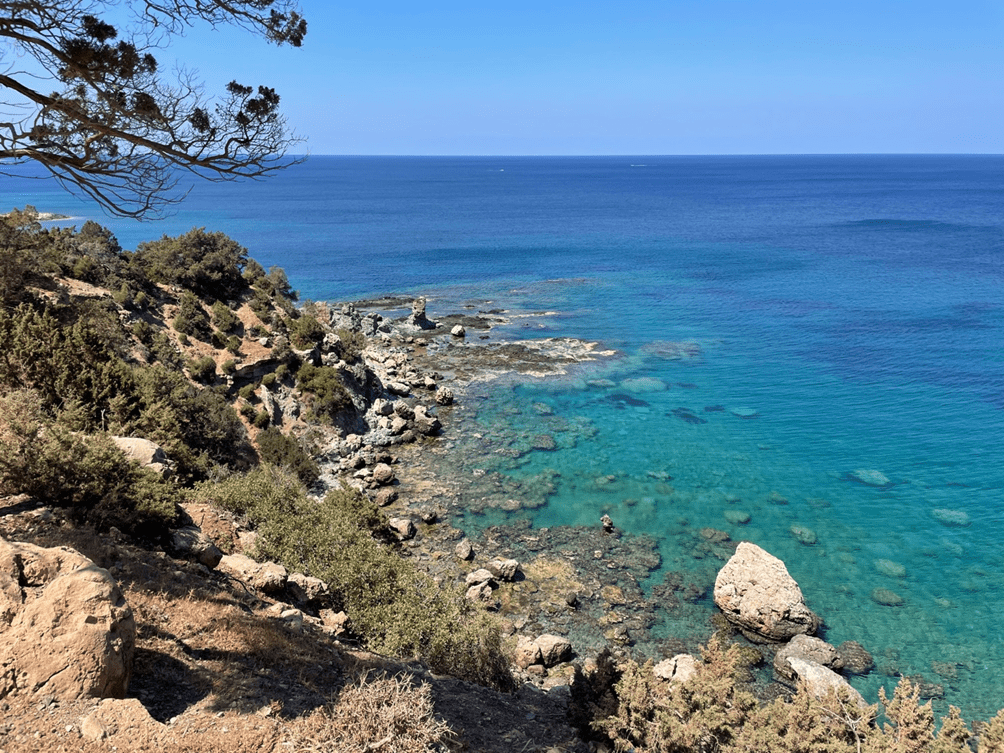
On the way back to Pafos we stop atAphrodite’s Rock Microbrewery, an English-style pub hidden among the trees in a cool valley offering craft beers and ciders made by an English family. Unfortunately, we arrived late and they were about to close but the very friendly owners sat us down for a tasting while they put everything away.
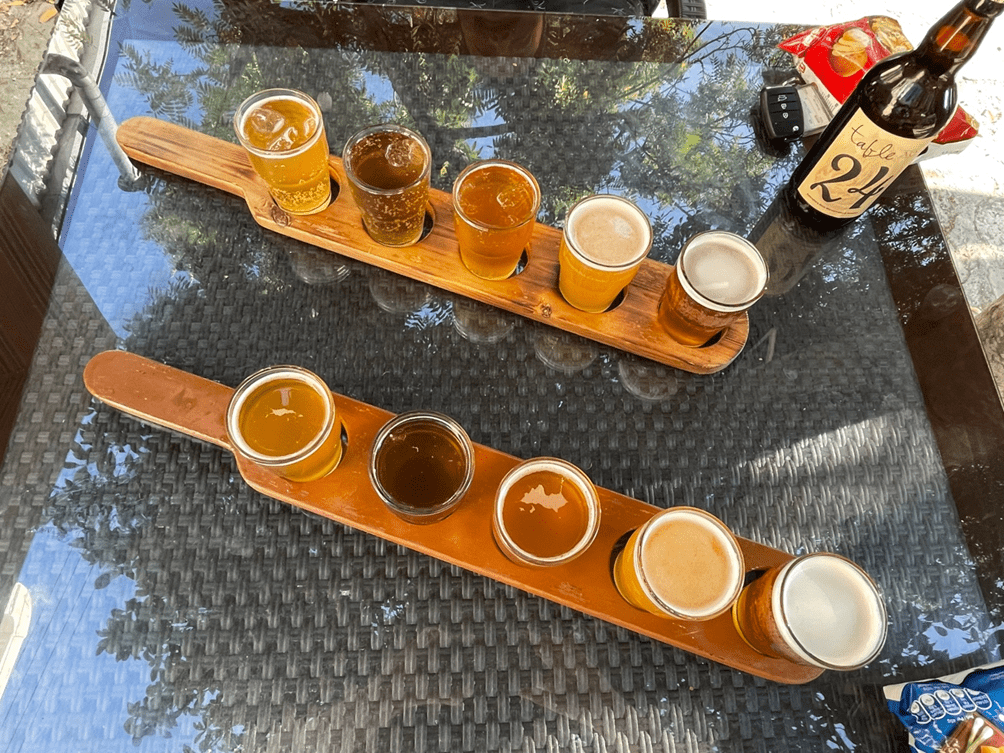
Day 6: Avakas Gorge Nature trail, Lara beach, Adonis Bath Waterfalls
Second day dedicated to the Akamas Peninsula Nature Park, we visit the southern part.
We begin with a 3 km hike in the middle of nature, which leads us up the stream to cross the Avakas Gorge . The route is of medium difficulty and winds through trees, oleanders and rocks until we cross the gorge. The nature is dense and the air is light. To get to the entrance of the gorges, you take a dirt road (which can also be travelled without a jeep) for about 2 km.
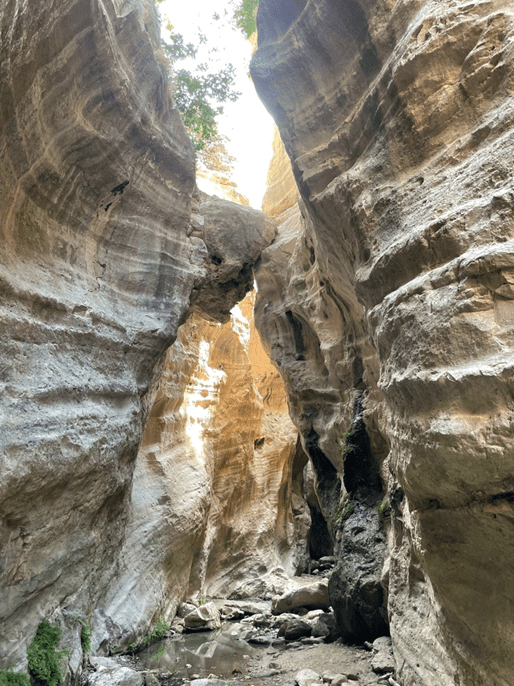

High up on a promontory, dominating the coast is an old castle, Viklari (The Last Castle), now a farmhouse. The view is indisputably one of the best in Cyprus. One eats in the shade of a vineyard at large stone tables and offers a set menu lunch with a choice of chicken, pork or mixed grill and a side of (giant) potatoes and Greek salad.
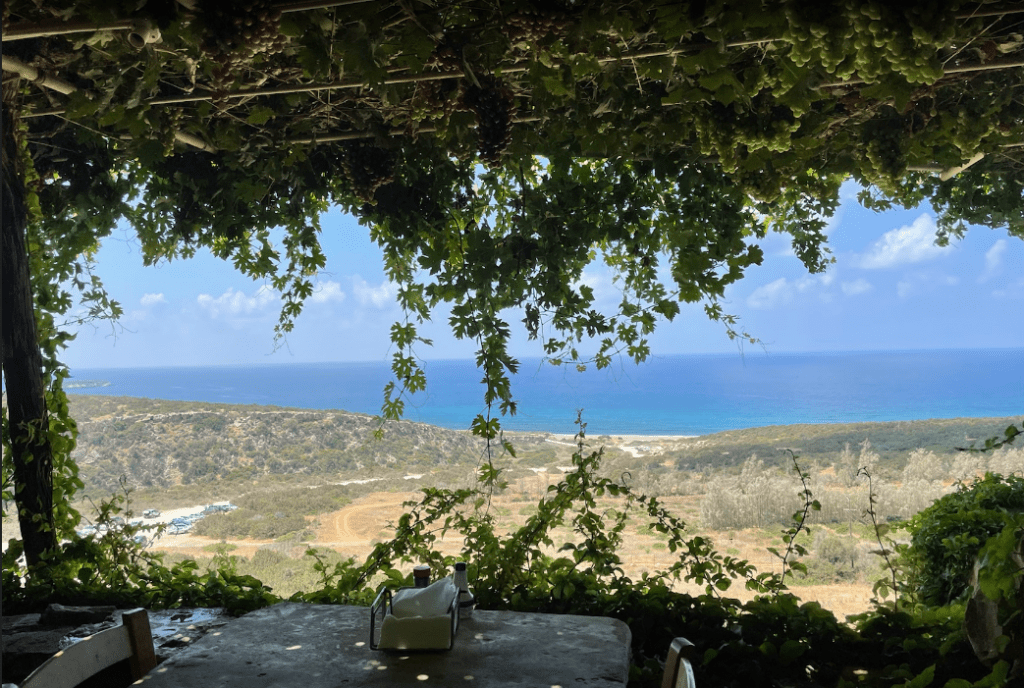
Returning to the main dirt road along the park’s shoreline, one arrives at Lara Beach, a spectacular bay of crystal-clear water surrounded by low hills dotted with Mediterranean scrub. Lara Beach is famous because it is the breeding ground of two rare species of turtle, the loggerhead and the green turtle. Almost the entire shoreline is a protected area, so it is not possible to plant beach umbrellas or sunbeds, light fires or stay overnight.

On the way back to Pafos we make a diversion to visit the Baths of Adonis. To get there, the road is bumpy but also doable with any car. The place is a somewhat dilapidated theme park full of kitch and giant statues and with a museum at the entrance that looks like an old house. Inside are two spring water pools (cold and unkempt) but you can launch yourself with a liana from a tree and do a bit of diving. Fun for sure, but not a must-see.
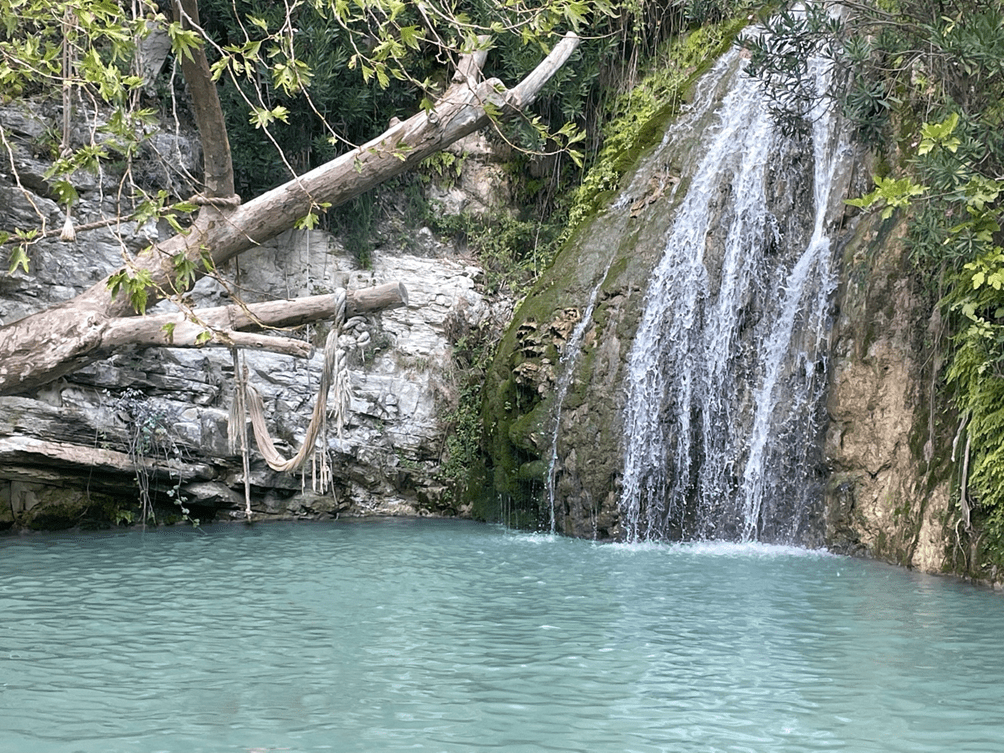
Day 7: Nea Pafos, Tomb of the Kings, Petrou de Romiou (Aphrodite’s beach), Nicosia
In Pafos, a visit to the excavations of Nea Pafos is a must. Part of the historical monuments are kept within a well-defined excavation area and are accessible by purchasing an entrance ticket. Other points of interest are located within the settlement and can be visited free of charge.
Tips for Trips: You will find useful the map you will receive at the ticket office, at the entrance to the site, which outlines a perimeter that also includes monuments outside the site but within Kato Paphos.
The entrance to the archaeological site of Nea Papos is at the very beginning of the harbour located before the fortress. The archaeological area is vast and one can admire, in addition to the agora and the Roman theatre, a series of mosaics preserved in the remains of what were originally noble houses: from the House of Dionysus to the House of Aion, to the House of Theseus and the House of Orpheus.
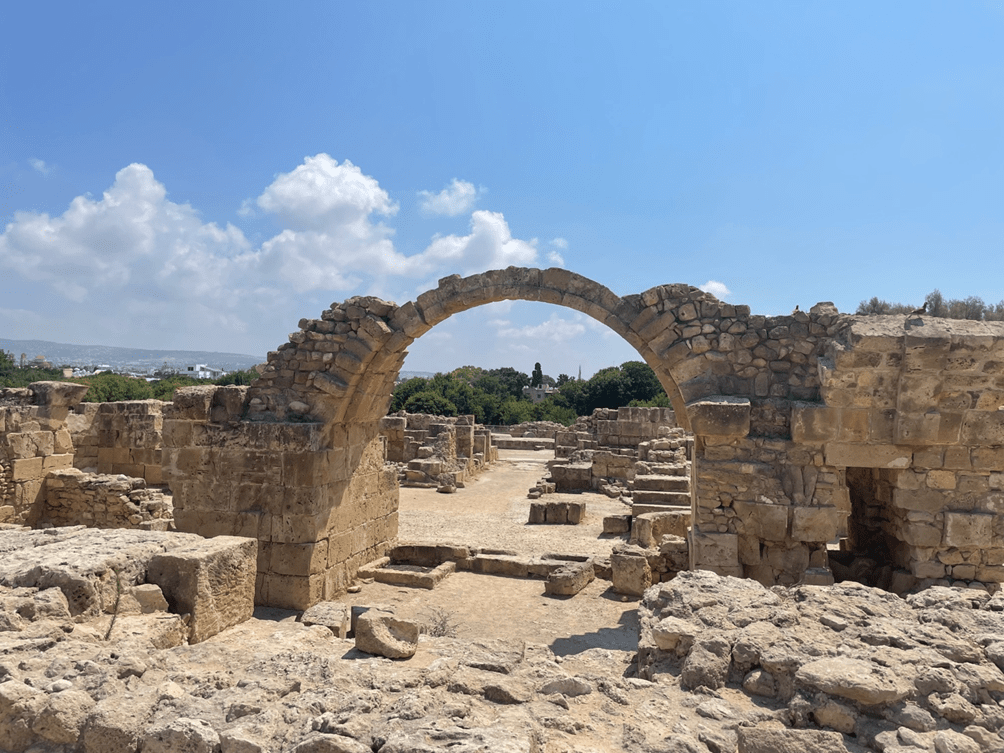
Outside the site, walking up towards the centre is access to the sacred area of the church of Agia Kyriaki and the remains of the Panagia Chrysopolitissa, while a short walk leads to the small underground church dedicated to Agia Solomoni, recognisable by the large tree at the entrance adorned with hundreds of handkerchiefs and rags left by the faithful in search of a favour.
We continue the day with a visit to the Tombs of the Kings, in my opinion the most beautiful archaeological site in Cyprus. This necropolis, symbolically called the Tombs of the Kings because of the magnificence of the tombs it houses, was used for the burial of the dead during the Hellenistic and Ptolemaic periods. The tombs were very elaborate structures with a courtyard, peristyle and columns and even today one can imagine their grandeur. The hypogea in this area were excavated from the 3rd century B.C. onwards and are located in an area of small escarpments and rocky cliffs, known as paleokastro (ancient city).

We get back into the car and drive in the direction of southern Nicosia, the longest drive awaits us.
On the road between Pafos and Limassol, we stop at one of the most famous beaches in Cyprus: Petrou de Romiou (Aphrodite’s beach). The beach is very easy to find because it is just off the main road that passes behind the sea. On the right is a parking area with a bar and a subway that allows one to get to the beach without crossing the main road on foot. It is considered the beach of lovers, in fact the shore is full of hearts built with the stones of the beach and the initials of the lovers. According to tradition, this was the place where the goddess Aphrodite was born from the waters and because of this legend, Cyprus is often referred to as ‘the island of Aphrodite’. The name of the place, which is literally called ‘Stones of Romios‘, derives from another legend according to which a folk hero, Dhiyenis Akritas known as Romios, in order to chase the pirates away from the island’s shores, hurled some enormous rocks at the invaders’ ships. This explains the striking stacks that lie a short distance from the shore.
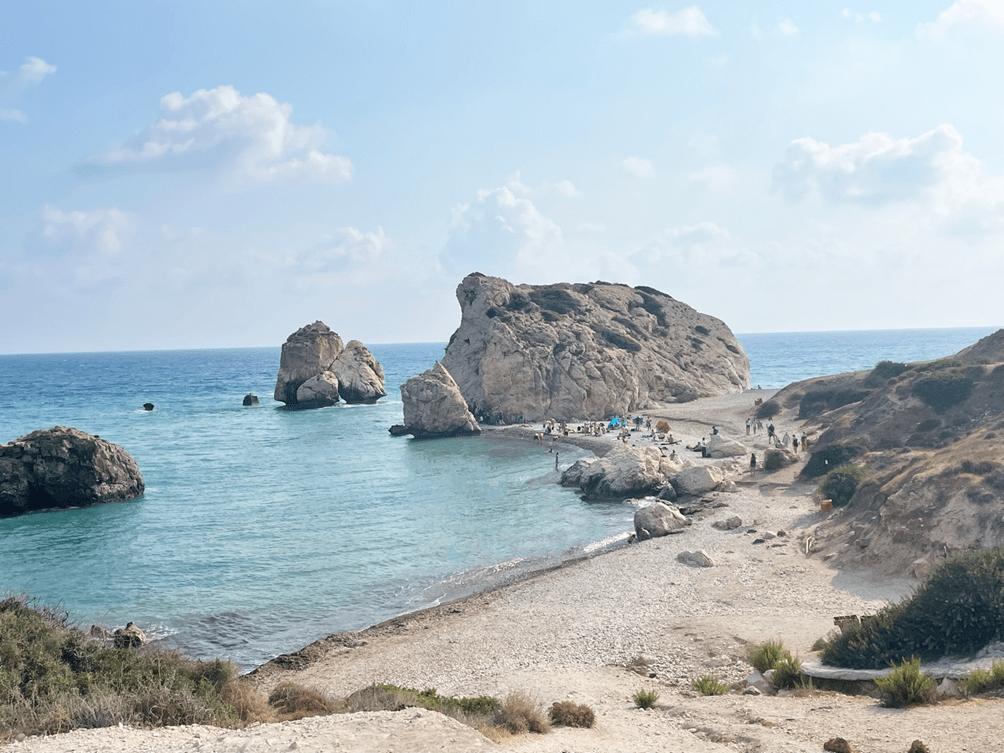
Day 8: Nicosia
A day dedicated to discovering the historical centre of Nicosia. Nicosia, (in ancient times Ledra) is the capital of the island, both of the Republic of Cyprus, the Greek part, and of the Turkish Republic of Cyprus, the Turkish part. It is the last city divided by a wall: they call it the Green Line, but it is a clear division, requiring the presence of the military and the need to show identity papers to cross the border. Following the green line made of petrol drums, sandbags and barbed wire, one comes across streets that lead nowhere, bordered by barricades that have been abandoned for decades, lined with decaying houses cut in half and gates closed by families who thought they would return soon and instead have not been reopened for 50 years.
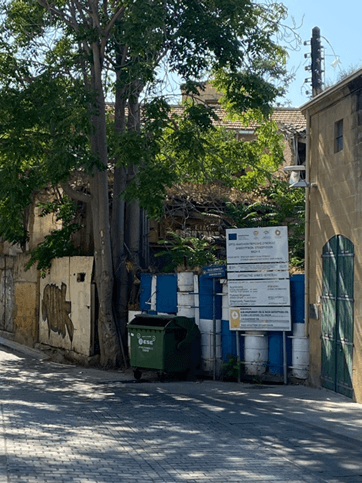
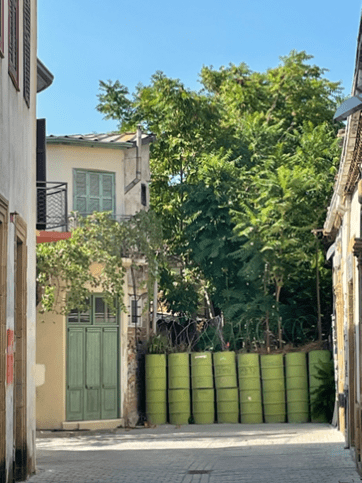
We start the tour from Lefkosia, the Turkish side. We go early in the morning to the Ledra street checkpoint, to make sure there is no queue to cross it. The passage is very quick, the passport control takes place at both stations but it is clear that, at least for tourists, it is only a formality. Once through customs, one feels catapulted into another world, the city seems dilapidated and at times abandoned. But moving from the streets close to the border, one discovers beautiful places, old gates along narrow streets, the beautiful icons of the churches and the tall minarets. We follow the streets to the Selimye Mosque and Haydarpass, the Kumarilar Hani caravanserai, the Armenian church and the Roccas and Mula Bastions. Special note to the Buyuk Han, a beautiful caravanserai built by the Ottomans in 1572 that served as a place of rest and refreshment for merchants and travellers. Today it houses craft workshops and a few restaurants where you can dine in the inner courtyard surrounded by a cheerful and spicy atmosphere.
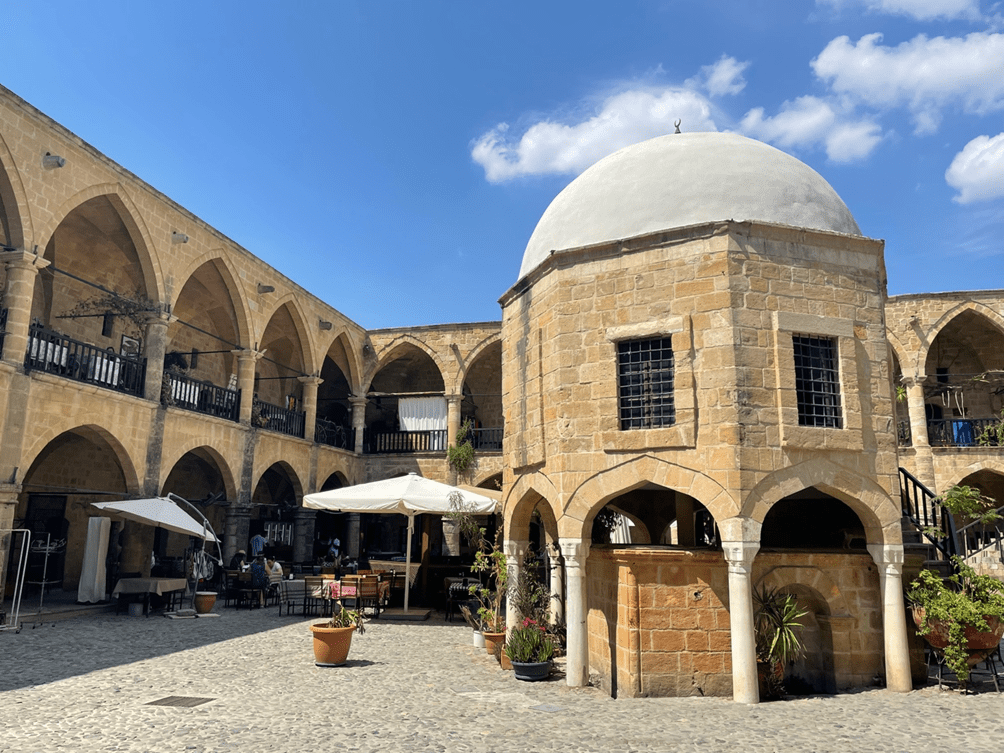
After lunch, we cross the customs again and return to the Greek side. We walk along Ledra street, which in summer is covered with tarpaulins hooked onto the buildings on both sides of the street to create a shaded area to shelter from the heat. We stroll through the walls of Nicosia, starting with Bastion D’Avilla and the Venetian Walls, the neighbourhood and the Church of Chrysaliniotissa, the frescoed Church of Agios Ioannis, the mosque and the house museum of Hatzigeorgakis Kornesios.
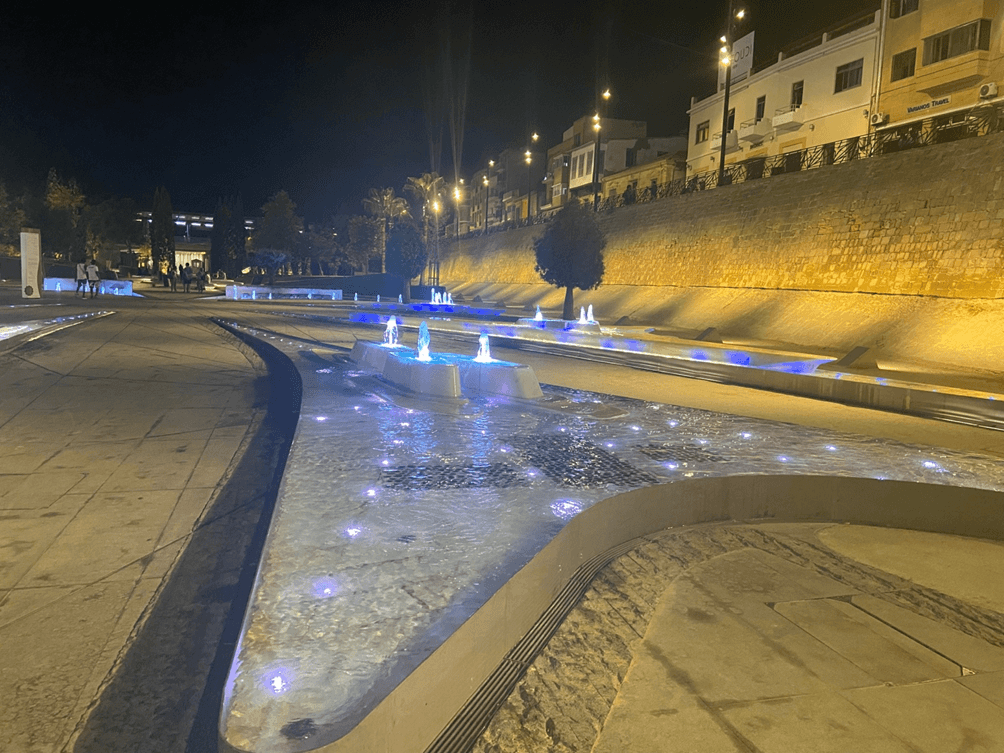
Day 9: St. Hilarion Castle, Kyrenia, Bellapais Abbey, Dipkarpaz
We cross the border for the second time, but by car. We wake up early so that we have time in case something unexpected happens. When we arrive at customs, we buy additional insurance for the car for the days we will be in the Turkish Republic of Cyprus. Even here the controls seem more like a formality.
Tips for Trips: insurance is bought at a separate booth from the one where they do passport control. If you are in the queue, you can get out and buy your insurance before the checkpoint. If not, they will hold your passport and make you pull over in special parking spaces. Once you show them your insurance, they will give you your passport back. WARNING: they only accept cash payments at the border, make sure you have the amount needed to pay for the insurance.
The first stop in the northern part is the Castle of Sant’Ilarione, which leaves us speechless. Sant’Ilarione was originally a monastery, named after a monk who supposedly chose the site, where a monastery and church had been built in the 10th century, as his hermitage. The castle is divided into three sections all connected by steep stairs. The middle and lower ones were used for services, while the upper one housed the royal family. The lower wing housed the stables and soldiers’ quarters. Prince John’s tower stands on a cliff above the castle while the church is in the middle wing. The upper wing was reserved for royalty and can be accessed through a well-preserved arched passage. Along the western wall, there is a breathtaking view of Cyprus and from the queen’s window, you can see the town of Girne. To get here, one has to cross a military road that closes fairly early at sunset in summer. The last entrance is at 5 p.m., so be careful not to arrive too late and perhaps try to visit the castle in the morning (in summer it opens at 9 a.m.), also to avoid the excessively hot hours given the climbs to be faced.
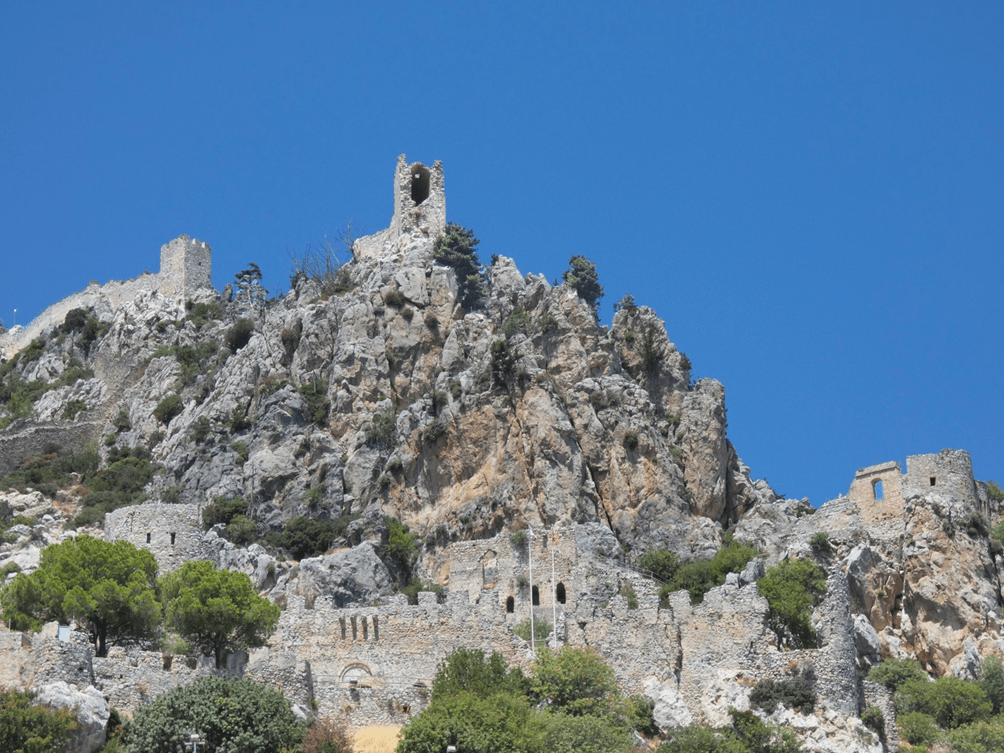
For lunch we head to Girne, the largest town in this part of Northern Cyprus. The old town is gathered around the bay and the old port of the city, built in medieval times and dominated by the military fortress. In addition, the coastline of Girne is full of small restaurants where you can enjoy freshly caught fish.
Continuing along the main road back inland, we arrive at Bellapais, a small village famous for its beautiful abbey. Bellapais Abbey is Gothic in style, with imposing arches and a large terrace overlooking the Mediterranean. The visit does not take long but it is a little gem that should definitely be visited. It has been called the most interesting Gothic church in the Middle East.
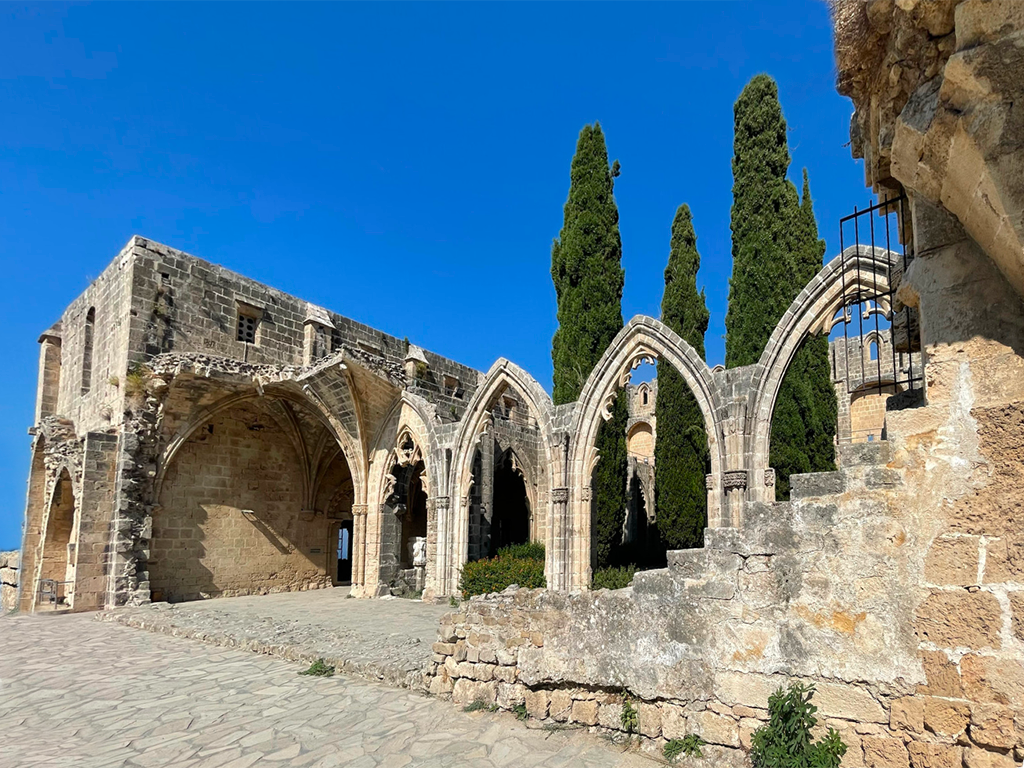
We get back in the car and drive to the wild Karpaz Peninsula . The place that will host us for two nights is a small wooden hotel close to the beach where the only noise is that of the sea and the stars are so bright that you feel as if you are seeing them for the first time. We spend the evening by the sea sipping Zivania.
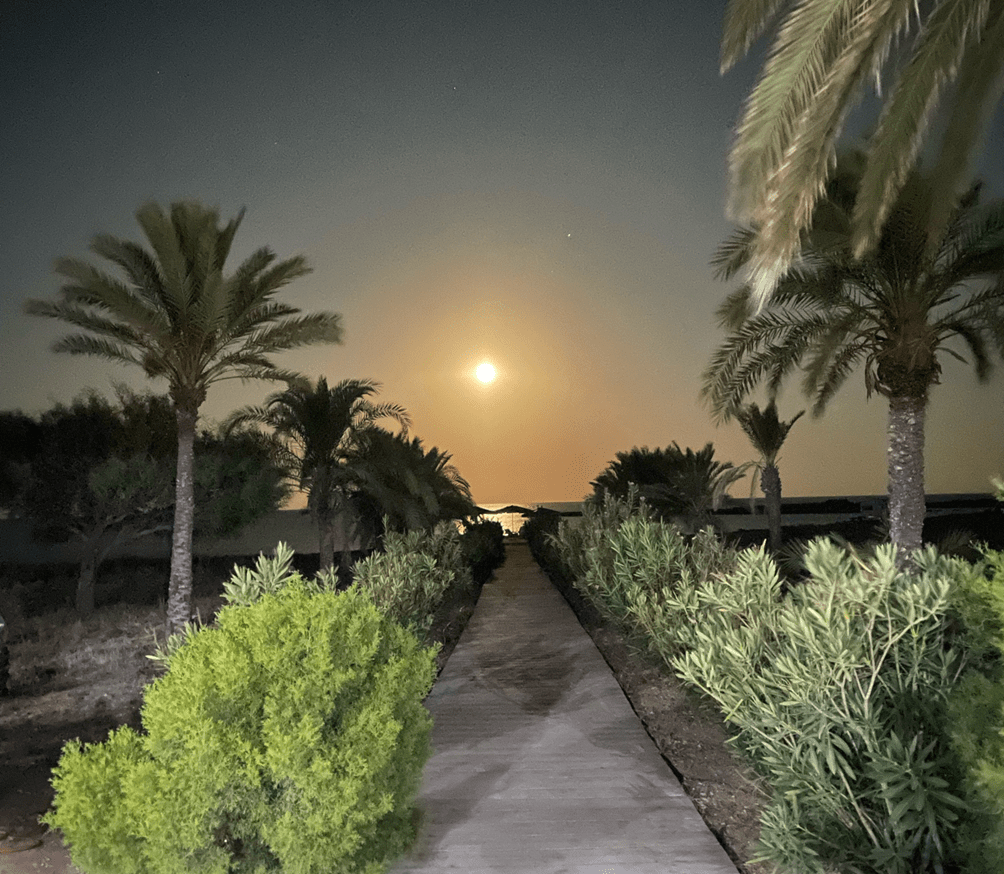
Day 10: Karpaz Peninsula, Golden beach, Sea Bird beach, Cape of the Apostle Andrew, Agia Filon
Day exploring the peninsula. The morning is dedicated to the wonderful Golden Beach, an expanse of golden sand with high white dunes behind it, Mediterranean maquis of centuries-old mastic trees and giant junipers. The beach can be reached by car through the protected nature park with tamarisk trees, wild olive trees, sheep and donkeys – a little intrusive but friendly and nice – free in the countryside.
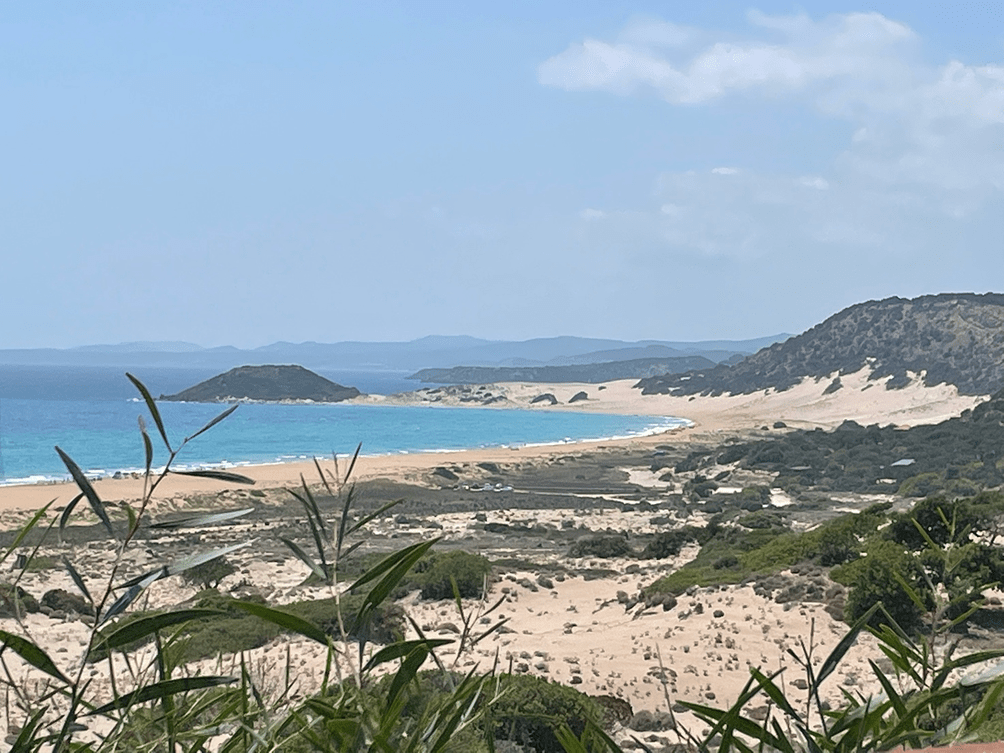
We have lunch in a small bar on top of a hill with a view of the entire coastline and continue our tour of the coves to the east. We are scheduled to stop at the Monastery of the Apostle Andrew but find it overrun with tourists so we watch it from a distance and continue on. Not to be missed instead is Sea Bird beach, a cove with crystal-clear, cool water where you can spend a few hours relaxing.
We then reach the easternmost point of Cyprus, the Cape of the Apostle Andrew (in Greek Ακρωτήριο Αποστόλου Ανδρέα, in Turkish Zafer Burnu, ‘Cape of Victory’). From here one can see the rocky islets known as te Kleides. Just before the extreme point, on the right, from a dirt road it is possible to walk to the top of a promontory where Turkish flags fly and from which one can enjoy an immense panorama of the entire coastline.
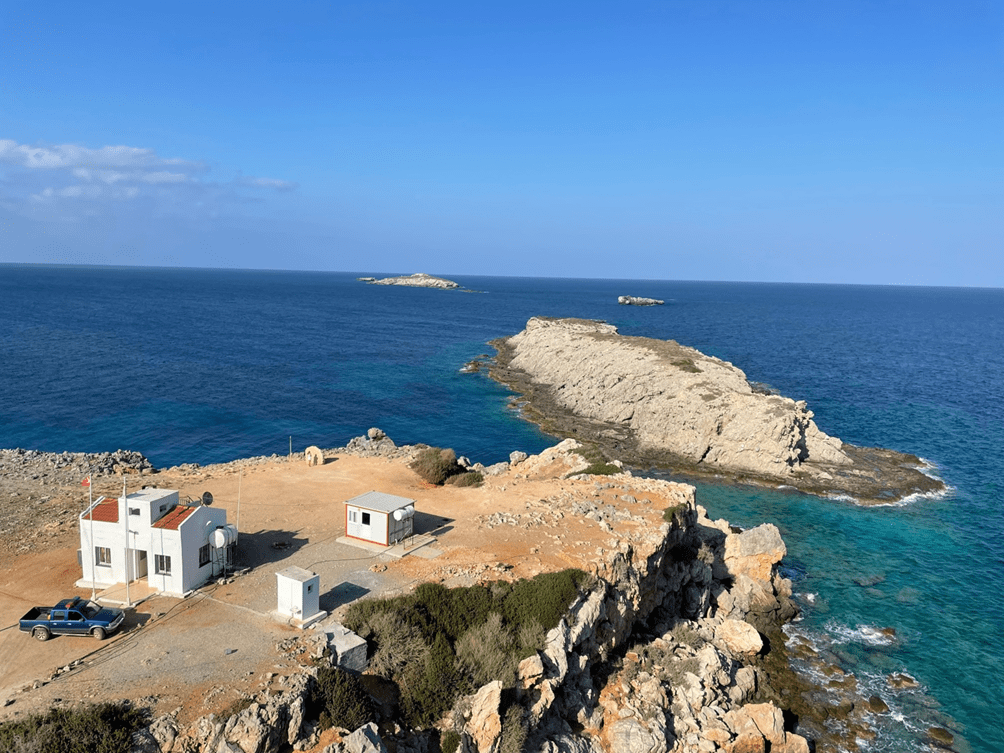
At sunset, we move to the opposite side of the peninsula. At the height of the village of Dipkarpaz, we turn left towards Agia Filon and its beautiful bay: the place is wild, with a few palm trees, a restaurant and the ruins of a church by the sea. Here the water has an intense colour and a thousand shades.
Day 11: Salamina ruins, Famagasta and Aya Napa
We leave the Karpaz peninsula and are about to visit two of the most famous stops in the northern part.
Salamina, a very impressive archaeological site, is one of the most famous tourist resorts in the Turkish Republic of Cyprus. Over the centuries it was first Greek, then Assyrian, Persian, Ptolemaic and finally Roman. The period of greatest splendour coincided with Roman rule: the Gymnasium, the Temple of Zeus, the Theatre of Augustus, the Baths and a Villa tell of the splendour and wealth in which the city lived from the 1st to the 6th century AD.
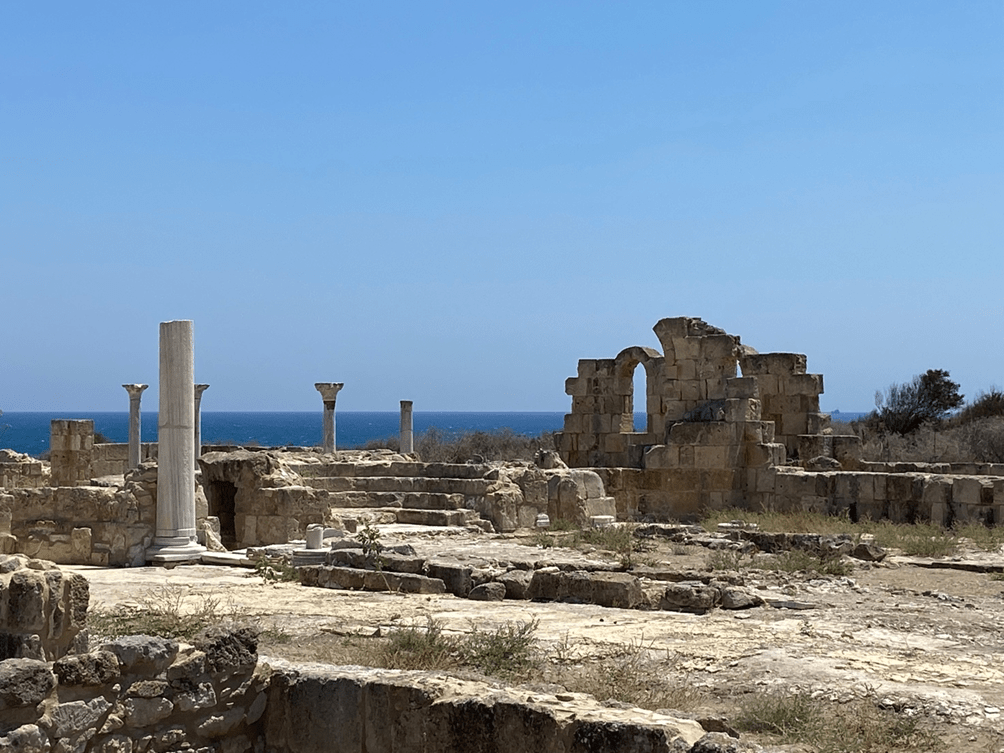
We then arrive in Famagusta (the ghost town), another unmissable stop. Having little time to spare, we concentrate on visiting the Citadel, a fortification of Lusignan origin, accessed through the Terra Gate. Arriving on the main pedestrianised square, we visit the Cathedral of St Nicholas, now the mosque of Lala Mustafa Pasi. On the opposite side of the church are the arches and supporting columns of what was once the Provveditore’s Palace. Opposite are the striking ruins of the Church of St Francis. A little further on is the beautiful Church of Saints Peter and Paul, now the mosque of Sinan Pasa. The grandiose Byzantine church of St George of the Greeks, of which only the huge apse, a side wall and part of what used to be the entrance to the church remain. Finally, on to Othello’s tower and the ramparts surrounding the old town to observe the meadows, vegetable gardens and streets from which the ruins of dozens of Byzantine churches sprout.
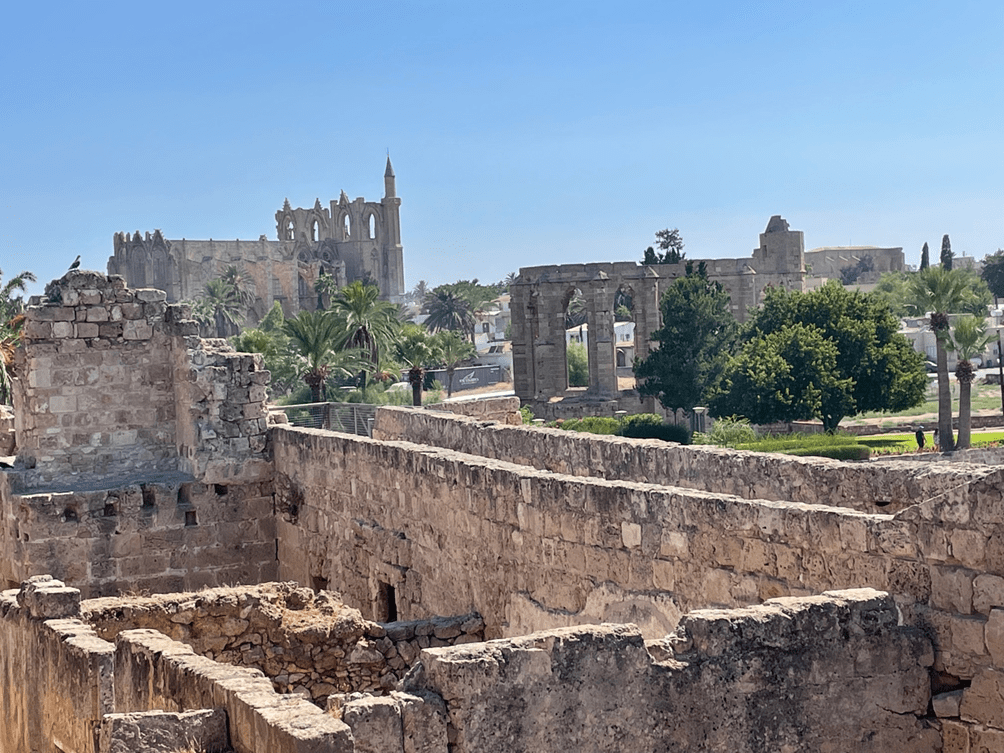
We get back into the car and leave the Turkish Republic of Cyprus behind us with the knowledge that we have not spent enough time discovering this part of the island, with its controversial nature, but with a wild charm and ancient beauty that has impressed us to the core. We cross the border for the last time and this time they ask us a few more questions, check the boot, but in a few minutes we are back in the Democratic Republic of Cyprus.
Arriving at our destination, Aya Napa welcomes us with glittering lights, loud music and a centre full of kitschy clubs. The contrast between the two areas is strong and once again it feels as if we have changed worlds. But, city centre aside, it is the coastline of this part of the island that interests us; we dedicate ourselves to relaxation and the sea.
Day 12: Gliki Nero Beach, Bridge of lovers, Ammos Kambouri Beach, Limnara Beach
In the morning we relax at Glyki Nero beach, one kilometre east of Aya Napa. Its name means ‘fresh water’ in Greek and derives from the fact that there was once a freshwater spring gushing from the rocks at the edge of its shoreline. It is a well-equipped beach with the possibility of enjoying many water sports. At the top of the hill there are many restaurants and typical taverns. We chose this beach because it is an excellent starting point for a walk along a well-trodden path through the fabulous coastline of the Greek cape park.
Tips for Tips: all beaches are equipped by the municipality and you can rent a beach umbrella and two deckchairs at a fixed price of 7 euro for the whole day.
After lunch we walk through the shores of the park. We stop at the Bridge of Lovers for a few photos.
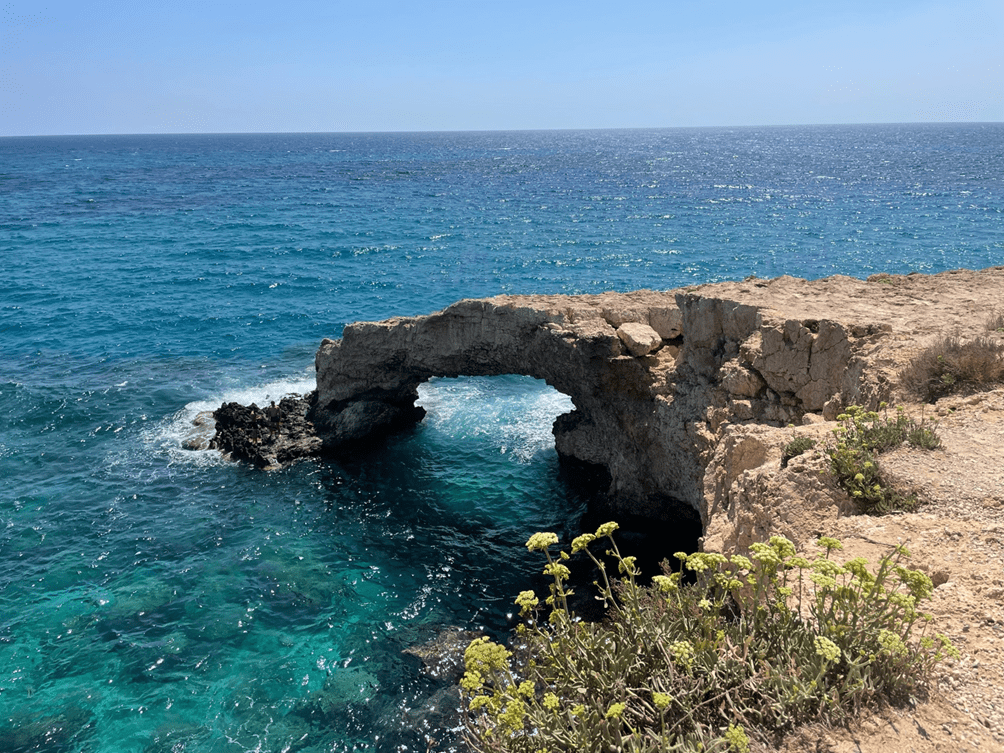
We cross the Wooden Bridge with locks, more because of its street than its beauty. We treat ourselves to a swim and a cool drink atAmmos Kambouri beach. Finally, some relaxation on Limnara Beach before retracing our steps. After this first day, our expectations of the park were certainly not disappointed, the coast is fascinating and the sea crystal clear.
Day 13: Nissi and Macronissi beach
We concentrate on the west coast, visiting the famous beaches of Nissi and Makronissi.
Nissi Beach is nestled in a beautiful bay and is considered one of the most beautiful beaches in the Democratic Republic of Cyprus. A small paradise of soft white sand, bathed by a crystal-clear sea that goes from azure to turquoise to bright blue with sandy seabed. All around is an almost exotic setting with palm trees, surrounded by green mountains that join sea cliffs and a small islet suspended in the sea that can be reached with a very short walk in the water. During low tide days this submerged path emerges dividing the sea in two. The beach is visited by many tourists. It is best to arrive early in the morning to enjoy the clear water and a bit of calm before the arrival of mass tourism. The beach is very well equipped and on the shoreline there are many restaurants, taverns and places to eat. In the afternoon the beach comes alive, there is dancing by the sea and (alas) foam parties.
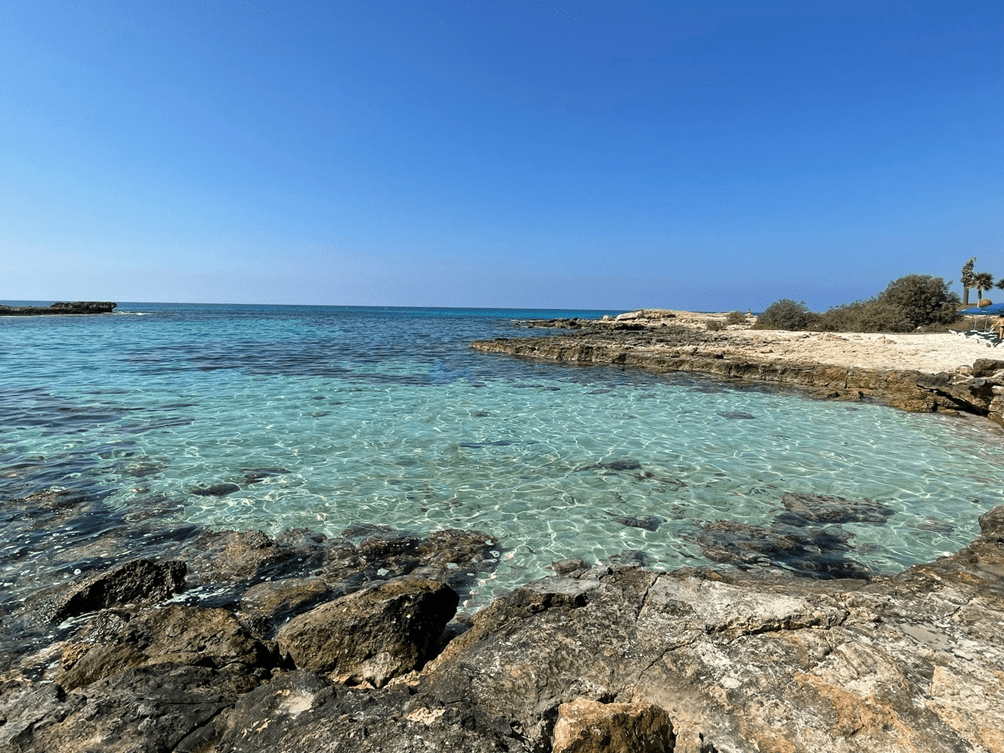
Further east is Makronissos Beach, decidedly quieter but just as beautiful. Also, for those who feel like exploring, there are many paths leading from the main beach to other small beaches. There is also a small lagoon that has formed and blends into a small area with the sea. By following the signs you will arrive at the ancient tombs by the sea.
Day 14: Konnos beach, Cyclops cave, Blue Lagoon, Greek Cape, Sea caves
In the northern Cape Greco Forest National Park is one of the most beautiful beaches in Cyprus, Konnos Bay. The beach is enclosed in a beautiful bay with rocky mountains behind it that provide breathtaking scenery from above. A shoreline of white sand with silver highlights due to its volcanic origins, washed by a deep turquoise sea with crystal-clear waters.
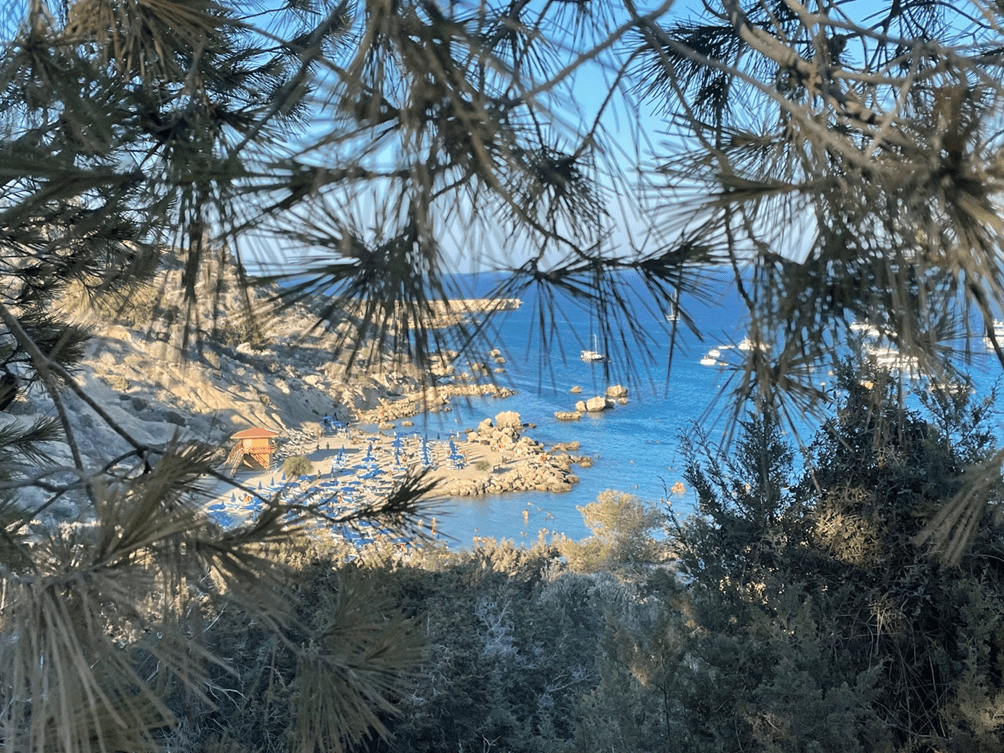
From here, a series of nature trails lead through the rugged coastline full of bays to the Ciclopi Cave.
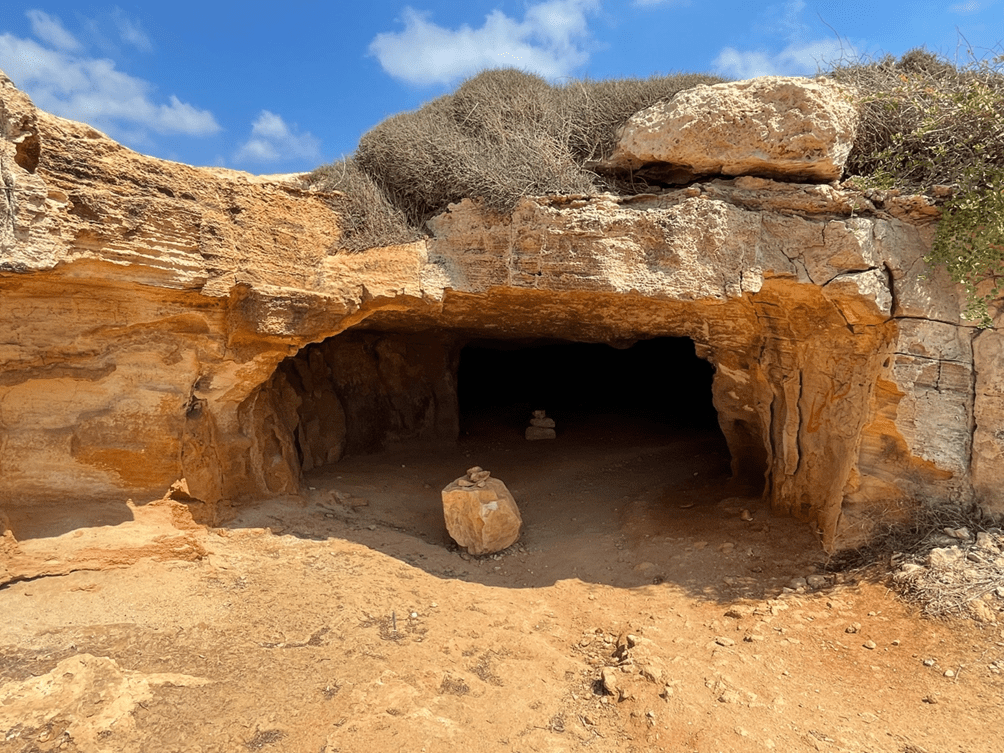
In the afternoon, we drive through the heart of the park to the Greek Cape, walk along the dirt tracks where a multitude of flowers, plants and rare vegetation can be found and foxes, hares and hedgehogs can be spotted, and look out over the park’s high rocky coastline. Finally, we stop at the Sea Caves, an unparalleled spectacle of nature; we are enraptured.

Day 15: Departure
Our plane leaves in the afternoon so we spend our remaining time wandering around cape Greco, and its spectacular nature, and after a last lunch overlooking the sea we head to the airport. The taste of Cyprus will stay with us for a while yet….
Read our tips on the 10 places not to miss in Cyprus!
Last modified: 14 June 2025
